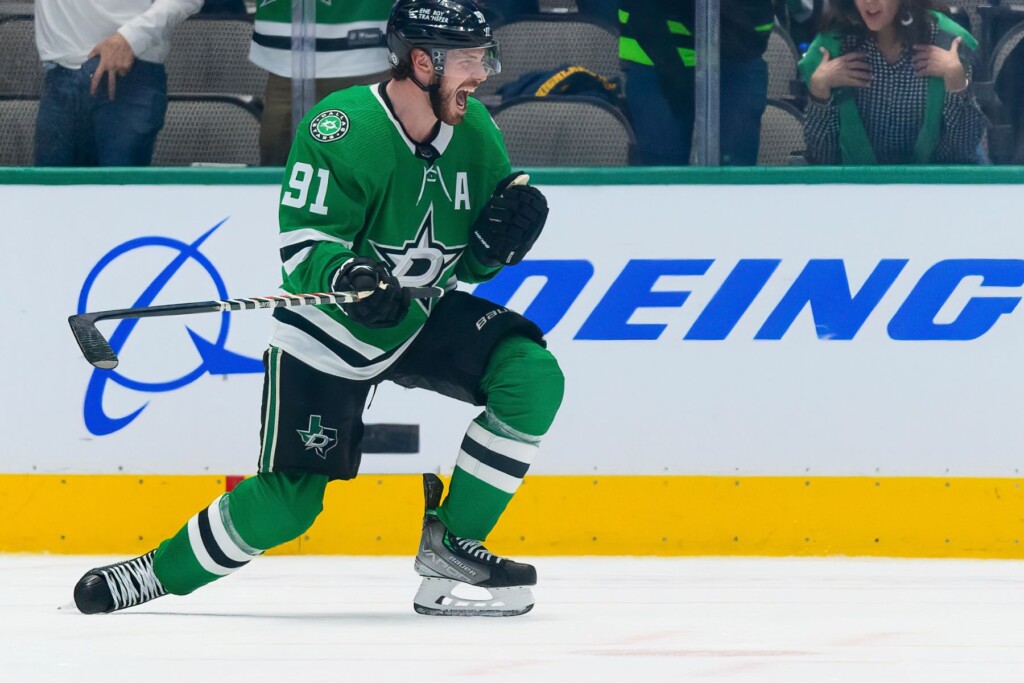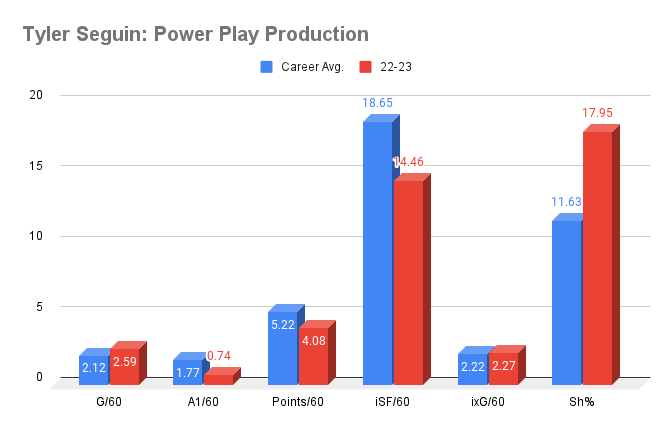Tyler Seguin is not coming back. At least not the kid who dazzled the NHL with his quick-step crossovers and the puck equivalent of Predator’s shoulder cannon. Even the chemistry he had with Jamie Benn is gone. Once one of the game’s premier pivots, Seguin is now just part of a middle-six casserole on a team increasingly stacked with forward ingredients, both young and old. However, there’s a cliche about great fighters always having one great fight left in them.
It happened with Benn last year. Why not Seguin?
At first glance, that looks like an impossible task. For one, Benn had a hulk named Wyatt Johnston. Benn was also on the first power-play unit, next to the best forward trio in all of hockey, along with Norris Trophy candidate Miro Heiskanen. Seguin won’t be next to a superstar rookie, and he won’t be on a power play with the potential to double his career average in points, as Benn did, going from a 16-point average on the man advantage to 30 (!) last year.
Seguin will have to follow a much choppier path, but the end result should be the same: a genuine comeback. The first thing working in Seguin’s favor is a regression to the mean. Unlike Benn, who was surrounded by a perfect storm of advantages, Seguin was largely left on an island. As if the hockey gods haven’t put his body through the ringer, he had yet another injury, and he got zero consistency from his linemates. Aside from Mason Marchment, you might be surprised to learn that the next most common forward Seguin played with was Radek Faksa, followed by Joe Pavelski, and then Ty Dellandrea. Unsurprisingly, his production suffered.
The chart below is straightforward: a collection of various offensive stats, comparing Seguin’s production at even strength for his career (blue) versus last year (red).
Little went right from a production standpoint. His goals, primary assists, points, shots, and shooting percentage were below or well below his career average. To his credit, his expected goals remained high, meaning he’s still getting to the high-danger areas. It would also be hard for Seguin to duplicate such a low shooting percentage even if he tried. Apply his career average (9.62 percent) to last year’s shot total, and he’d have tallied an extra three goals. It’s not groundbreaking, but we’re talking about a player who has gone above 10 percent at even strength in four seasons. The work is there; the reward should follow, especially in Pete DeBoer’s system.
That said, we need to talk about another potential course correction: the power play. The picture is a little murky at first, but quite clear once we step back.
Seguin’s power-play production looks OK on the surface. His shooting percentage last season nearly doubled from his career average, but his overall production took a serious nosedive, thanks in part to the lack of primary assists. For most of his career, Seguin has been able to rely on an extra 20 points through an 82-game season on the PP. Last year he tallied only 11.
It’s important to look closer at this point because top scorers need this. For anyone who has bothered to read the fine print when it comes to expected goal models, you may find it odd that baked into the calculus is how many penalties a player takes versus how many he draws. Why is that? Because at even strength, a two-minute stretch of hockey has an 8 percent chance of producing a goal. On the power play, a two-minute stretch has a 24 percent chance of producing a goal. The most gifted offensive talents tend to maximize those two minutes. Seguin is no different; 34 percent of his career production has come from it.
The Stars are an elite team. The fancy stats love them, giving them the second-best odds to win the Cup. But they’re not perfect, and nowhere does that imperfection play out more than on the second power-play unit. It’s a really nice house, but nobody wants to fix the hole in the wall of one of the bedrooms.
This is admittedly a crude chart, stacking various stats from the most-used second-unit players on top of one another. But I found it useful to show how well Seguin, Johnston, and Marchment do their jobs compared to the league average, and why we should expect them to do well. Seguin is especially noteworthy for playing well beyond his man-advantage peers. However, the second unit never had a complementary forward, and then there’s Ryan Suter.
There’s no point in being diplomatic: Suter’s play flat out doesn’t warrant inclusion on the second unit. While it’s unfair to compare a defenseman’s power-play production to his forward counterparts, that’s why I included Nils Lundkvist, who comedically outranks him, into the graph. However, the main takeaway here is that Dallas theoretically has a second power-play unit that can juice Seguin’s point totals. Matt Duchene profiles as the perfect second-unit forward, and even if Lundkvist never gets the power-play time he deserves, Thomas Harley might be even better.
Seguin may not have someone like Johnston to help elevate his game the way Benn did, but Duchene is anything but a consolation prize for reasons that should be clear to anyone who has followed his underrated career. We can quibble over what should be the ideal lineup (and I often will), but his presence will upgrade the conditions surrounding Seguin.
As critical as Duchene’s chemistry is with him, these discussions always feel like minor disrespect for Seguin’s ability to strike a match and start anew over the last several years. Even with his offensive tools largely stolen from him, he has become a responsible, two-way center. Last season Seguin was behind only the Hintz line and Heiskanen in expected plus/minus at plus-8. The fanciest of stats profile Seguin’s performance as a borderline first-line forward in terms of net rating despite his meager production due to how well he impacts both ends of the ice.
We can talk all day about big-picture stuff, and why Dallas needs Seguin more than ever. But I think his real value is as much about the bounceback year he’s about to have as it is about what that bounceback would symbolize.
In recent years he has been denied everything that was available to him in his prime: elite linemates, a high-octane system, time on the top power-play unit, and healthy legs. Through it all, he’s kept his head down and put in work that the hockey gods have yet to reward him for. Nothing has been given to him. He has had to take it. That has to be the Stars’ mentality, too, if they want to take home a Cup.
Author










